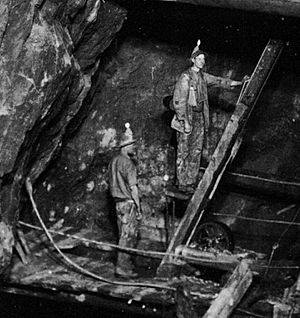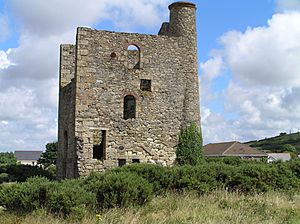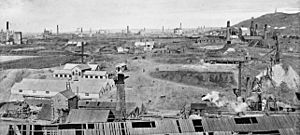Dolcoath mine facts for kids
Dolcoath mine (which means 'Old Ground' in Cornish) was a very important copper and tin mine in Camborne, Cornwall, England. People often called it The Queen of Cornish Mines because it was so successful. The mine was located north-west of Carn Brea.
Contents
History of Dolcoath Mine
The land where the mine was located belonged to the Basset family. Records show they leased the land for mining as early as 1588. By 1720, people were already digging for copper here. In 1746, the mine was almost 300 feet (91 meters) deep! It got even deeper, reaching nearly 600 feet (183 meters) by 1778.
The mine closed in 1787. This happened because a lot of cheap copper was being found elsewhere, which made the price of copper drop. But the price slowly went back up, and Dolcoath Mine reopened in 1799.
From Copper to Tin Mining
Dolcoath became one of the biggest copper mines in Cornwall. However, as miners dug deeper, they found less and less copper. By 1832, the mine was almost going to close again. But the mine captain, Charles Thomas, believed there was tin deeper down. After some disagreements with the owners, his belief paid off! The mine started making money from tin in 1853.
By 1882, the mine was incredibly deep, reaching 2,160 feet (658 meters). It had about 12 miles (19 km) of tunnels that miners could use. There were also another 40 miles (64 km) of old tunnels that were no longer used. In 1893, there was a serious accident at a depth of 412 fathoms (about 2,472 feet or 753 meters).
Because it was so deep, it took miners working in the lowest parts a long time to get to and from the surface. In 1895, it could take 2 to 3 hours just to travel up and down! This meant they could only work for about 4 to 5 hours a day.
Dolcoath became the largest and deepest mine in Cornwall. Its main shaft, called New Sump Shaft, eventually went down 3,300 feet (1,006 meters) below the ground. The huge pumping engine that kept water out of this shaft was built in 1815. It was so big that a special wooden extension had to be added to the engine house just for the stairs!
Changes and Closure
In 1895, the mine changed how it was run. It became a limited company, which was a more modern way to manage businesses. A new shaft, called the Williams Shaft, was started in 1895. It was planned to be the first 3,000-foot (914-meter) vertical shaft in Cornwall. It was finished in 1910 and started being used the next year.

In 1920, the mine had almost run out of valuable minerals. Also, the price of tin dropped a lot, and new tin deposits were found in other parts of the world. Because of this, Dolcoath Mine finally closed.
The company tried to restart the mine in 1923. They raised new money and dug a new 2,000-foot (610-meter) circular shaft. This "New Dolcoath Mine" actually combined several smaller mines. In 1936, another mining company, South Crofty, bought the Dolcoath mining area.
What Dolcoath Mine Produced
Before it first closed in 1788, Dolcoath Mine was estimated to have produced copper and tin worth at least £1,250,000. From 1799 until its final closure in 1920, the mine produced minerals worth over £9 million! This included arsenic, silver, and other valuable materials.
From 1853, when it started making money from tin, the mine produced over 100,000 tons of "black tin" (which is tin ore). This was much more than any other mine in Cornwall. In 1896, the mine was getting about 80 pounds (36 kg) of tin from every ton of rock. This amount slowly went down to 30 pounds (14 kg) by 1915, and stayed at that level until the mine closed.
Because it was so successful, the mine often paid money to its shareholders (the people who owned parts of the company). Its shares were nicknamed 'Dollies' and were very popular among investors.
Mine Captains
Mine captains were like the managers of the mine, in charge of the daily operations and planning.
- Richard Trevithick (father of the famous inventor Richard Trevithick): He built a deep drainage tunnel in 1765 and installed a Newcomen pumping engine around 1775.
- Andrew Vivian: He was a cousin and partner of the younger Richard Trevithick. He left in 1806.
- J. Rule: Took over from 1806.
- William Petherick: He died in January 1844.
- Charles Thomas: From 1844 to 1867. He pushed for deeper mining, which led to the discovery of large amounts of tin ore.
- Josiah Thomas: From 1867 to 1895. He was Charles Thomas's son and continued his father's work. He brought in new machines like boring machines (1876) and Californian stamps (1892) to help with mining. He became the managing director in 1895 and passed away in 1901.
- Arthur Thomas: From 1895 onwards. He was Josiah Thomas's son.
Images for kids




